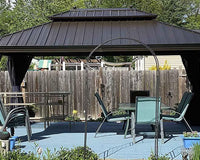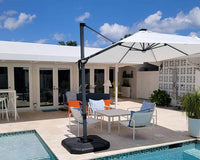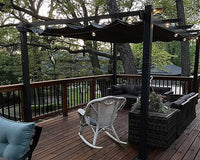Although the sight of birds enhances the appeal of outdoor living, their presence in your gazebo could not always be appreciated. They might disturb the quiet atmosphere, nest, leave droppings, and From creative architectural changes to natural deterrents and high-tech tools, this article provides a bird's-eye perspective of safe, humane techniques to discourage these flying guests so you can enjoy your gazebo without the avian assembly. Come along as we negotiate this common problem with practicality and care for our flying neighbors.
1. Discouraging Perches by Smart Gazebo Design Choices
Simple design decisions can help to create an unpleasant habitat for birds. Birds detest some textures and colors; hence, choosing a gazebo material with a smooth finish and neutral or less vivid colors will help discourage them. These colors appeal less to them, and they are more likely to search for places where they might fit in for security.
Regarding structure, think about how strategically slopes or slippery covers should be placed on level places where birds may otherwise land or nest. This can involve utilizing metal sheeting that makes it challenging for birds to hold onto.
If employed properly, physical barriers can be ethical as well as successful deterrents. Lightweight netting can stop birds from reaching comfortable nook-and-cranny nesting sites without catching or hurting them. Bird spikes can be placed along edges where birds might rest for a more straightforward solution. These spikes make landing difficult, not meant to damage them. Make sure you use strong, long-lasting solutions that remain safe for any inquisitive species and resist environmental elements.

2. Planting and Positioning for Bird Control
Integrating bird-repelling plants around your gazebo can help you harness nature's own answers. Birds are said to prefer to avoid aromas emitted by some plants, including lavender, marigold, and lemongrass. Plant them in pots or garden beds close to your gazebo to naturally form a protective circle. They not only help to keep birds away but also enhance the appearance and aroma of your outside area.
Apart from gardening, think about applying these plants' derived essential oils. Acting as a safe repellent, a few drops of either citronella or peppermint oil diluted with water can be sprayed around the gazebo. To keep this combination working, refresh it often.
Arrange decoys of predatory birds, like hawks or owls, around your gazebo to create a more graphic deterrent. Smaller birds may be scared off by these predatory birds, which also prevents them from nesting nearby. Move these decoys sometimes to keep actual birds from becoming accustomed to their presence and understanding they are not a threat.

If you like creating your own answers, you may make a homemade repellant spray. Both vinegar and water, or employ crushed chili peppers steeped in water, are qualities birds detest. Around your gazebo, mist these concoctions to discourage winged guests without using strong chemicals. To guarantee ongoing protection, keep in mind to reapply following rain or on regular intervals.
3. Gadgets to Guard Your Gazebo
Birds find the sounds produced by ultrasonic devices unpleasant, but humans usually cannot hear them; so, an invisible barrier around your gazebo is created. Usually including customizable frequency settings to target different bird species, these devices can be installed at different sites.
Another easy but powerful choice is reflective tapes. With the slightest breeze or light, these tapes flutter and flash, shocking birds and deterring them from approaching. They fit very well into your gazebo's beams and railings.

Motion-activated sprinklers can provide a startling blast of water as a deterrent for those seeking a responsive option. These systems sense motion and temporarily turn on to shoo away birds without injuring them. You will find this approach will be especially helpful for larger birds that might not be moved by light or sound deterrents.
Consider things like the size of your gazebo, the kind of birds you deal with, and how covert you want the deterrent to be when selecting technology tools. These devices must have weather-resistant features if they are to withstand an outside environment.
Usually easy, installing these devices most come with instructions and can be done without expert assistance. Make sure ultrasonic devices and motion-activated sprinklers are positioned somewhere free from gazebo walls or vegetation. Usually, maintenance consists of keeping the gadgets clean and routinely testing batteries or power sources. If you are using reflective tapes, regular inspection is advised to repair any worn-out or loose parts, therefore preserving their effectiveness.

4. Ethical and Legal Bird Management
Discouraging birds from calling a clean and orderly gazebo home depends mostly on keeping it that way. Frequent food waste disposal, garbage bin closure, and removal of nesting materials quickly discourage birds from settling in. Eliminating any standing water will also help to reduce possible bird water supplies.
Dealing with birds calls for knowledge of local wildlife rules. Many species are safeguarded under different laws. Once their nests are formed, it is forbidden to disturb them. Preventing nesting before it occurs is crucial since the removal of active nests could require a permit or assistance from wildlife professionals.
Usually, it's advisable to see an expert if you have ongoing bird problems. Professional wildlife control services can provide legal and ethical answers catered to your particular needs. They can also offer guidance on legally compliant long-term preventative actions.
Seeking professional help is especially pertinent if you're dealing with protected species. These experts can ensure that any actions taken are both effective and abide by the ethical treatment of wildlife, maintaining the delicate balance between enjoying your gazebo and respecting the natural world.

Coexisting with Nature at Your Gazebo
Keeping birds away from your gazebo is a multifaceted endeavor that requires a blend of thoughtful design, natural repellents, and the latest in deterrent technology. By understanding and respecting the natural behavior of birds, employing plants and decoys to create an unattractive environment, harnessing technological aids without causing harm, and staying informed about legal wildlife protections, you can enjoy a clean, peaceful gazebo. Remember that consistency in maintenance and being adaptable with strategies are key. With these humane and effective methods, you can strike a balance between the beauty of nature and the comfort of your outdoor haven.




